
08/16/2024 by Christine Morris
Increasing Severe Weather & Supply Chain Disruption: Are You Prepared?
Severe weather events are the new normal. Can the logistics industry handle more supply chain disruption?
It’s a hot, sunny day, and you’ve found the perfect spot on the beach to sit back, relax, and enjoy the cool breeze of the ocean waves. As you’ve sat down and unpacked your snacks, a thunderstorm rolls in, causing the lifeguards to hop off their chairs, stating the beach is closing. Plans = ruined.
We’ve all been there – when poor weather makes an inconvenient appearance. But severe weather is more than just rain on your wedding day. It’s more extreme, like high winds, flooding from heavy rain, wildfires, or droughts. Severe weather events are becoming more intense and commonplace, causing supply chains to struggle. Logistics professionals often face challenges like disrupted deliveries, product shortages, and skyrocketing costs.
From intense hurricanes to wildfires, the growing effects of climate change on supply chains are becoming impossible to ignore. In a report by Breakthrough, 39 percent of transportation professionals note severe weather as the biggest challenge to their networks, having primary concerns surrounding climate change and sustainability. With severe weather and its effect of supply chain disruption being a challenge for companies for the foreseeable future, they must take proactive measures to maintain resiliency. Is your supply chain prepared?
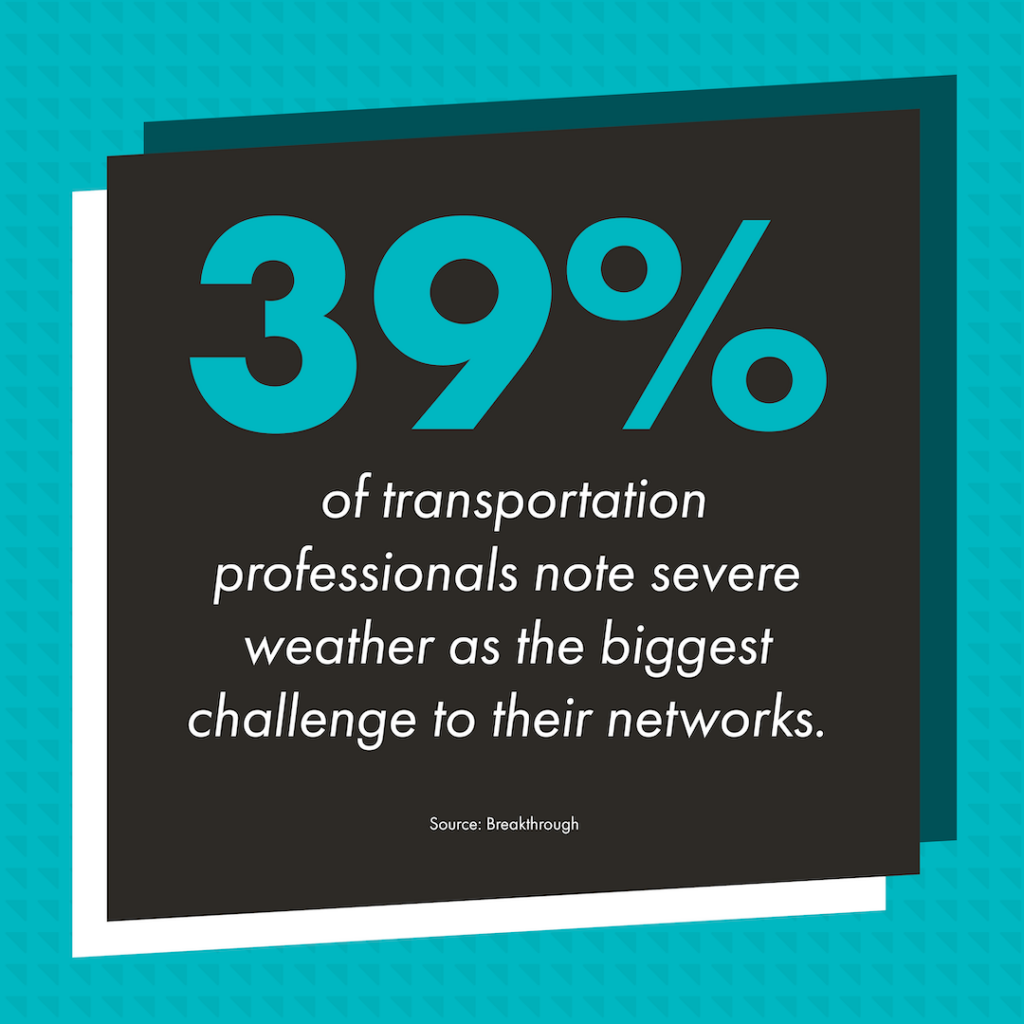
CASES OF SUPPLY CHAIN DISRUPTION FROM RECENT SEVERE WEATHER
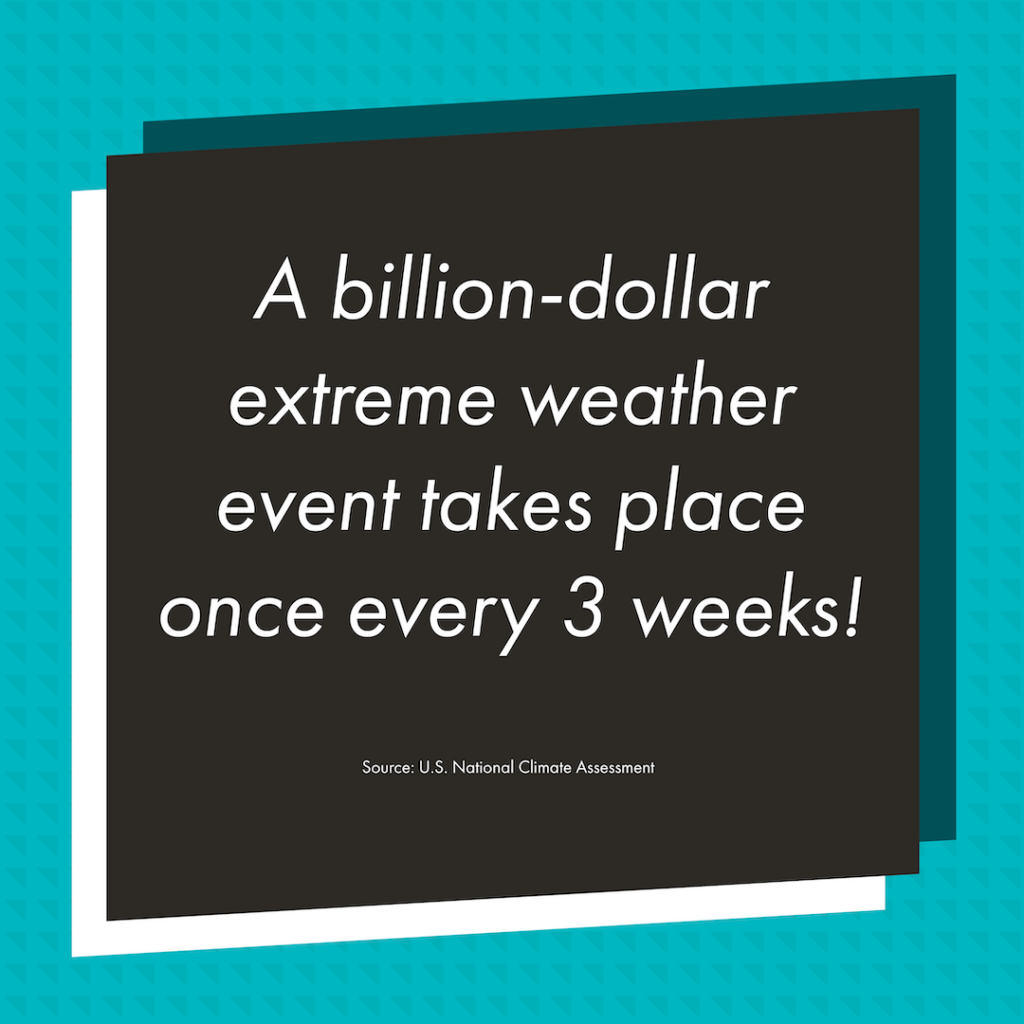
Climate change has led to an increase in severe weather events. If you’re uncertain as to how much of an increase we’ve seen, let me share an eye-opening fact with you. The U.S. National Climate Assessment estimates that in the 1980’s, a billion-dollar extreme weather event would take place once every four months. Now, they occur once every three weeks! That’s not a lot of downtime in between events for affected supply chains to regroup.
Supply chain disruption from severe weather like the ones mentioned below is no longer a distant worry but a constant concern.
Droughts
In recent years, droughts have been impacting vital waterways. The Panama Canal, a critical path for global shipments, has experienced its worst drought since records began in 1950. Due to low water levels, restrictions were imposed, limiting heights and the number of daily vessels. Similarly, the Mississippi River has faced periods of drought and low water levels, making it difficult to transport goods.
Elevated heat and droughts affect not only waterways for transportation but also the production of goods. For example, coffee, cocoa beans, and olives have all recently faced drought conditions, resulting in a lower output of their respective products.
Wildfires
Often fueled by extreme heat and droughts, wildfires are now an expected annual danger to many parts of the world, like the Western U.S. and parts of Canada. Fire seasons start earlier and last longer while growing in intensity and size. Though the wildfires themselves are one problem, the spread of the smoke coming off them greatly expands their impact. The smoke reduces not only our air quality but also visibility, such as with the wildfires in Canada in 2023, which created widespread smoky conditions and delayed several shipments in populated locations such as Chicago and New York.
Hurricanes
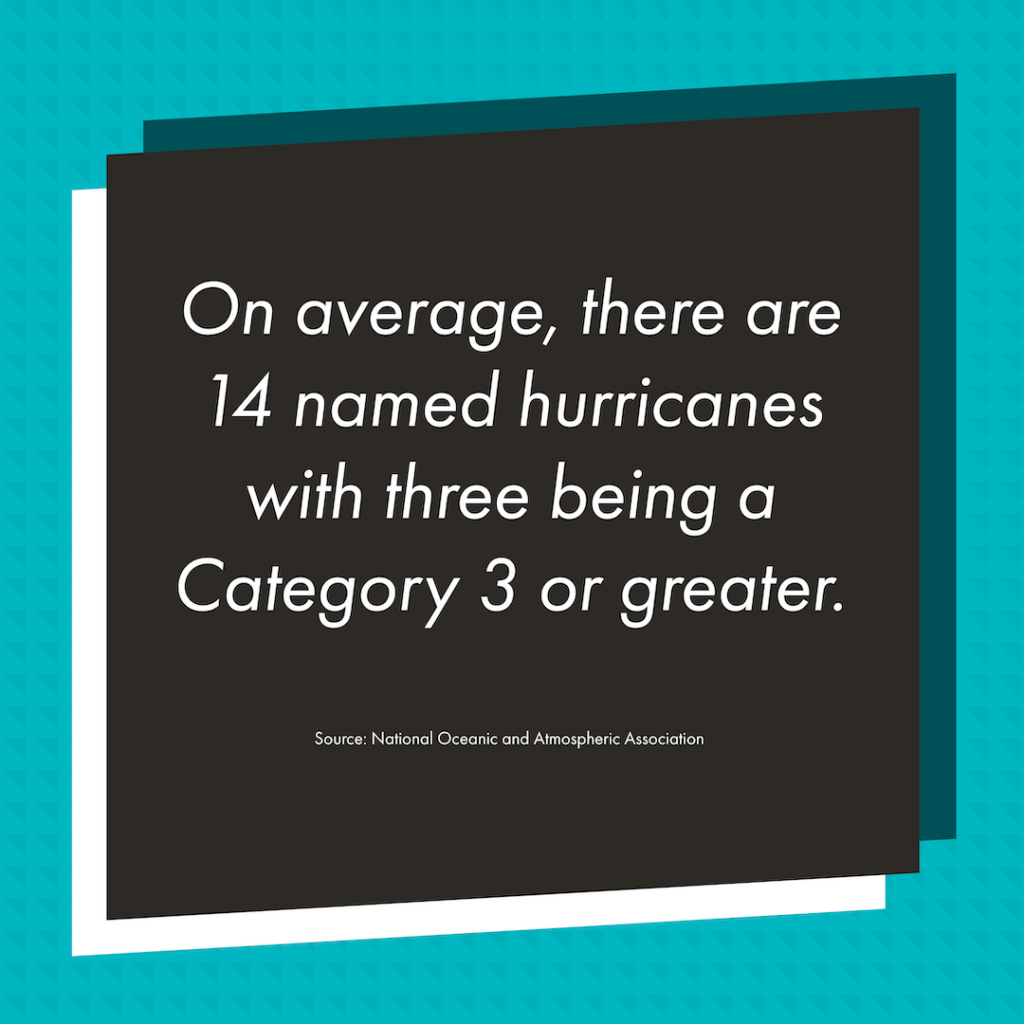
Hurricane Season continues to bring more hurricanes and stronger storms each year. In fact, the National Oceanic and Atmospheric Association (NOAA) forecasts that the 2024 season will see 17 – 25 named storms, with four to seven being a Category 3 or greater. On average, there are 14 named storms with three being a Category 3 storm or greater.
Hurricane Ian was one severe weather event to cause supply chain disruption in the Southeast in 2022. Ian was a Category 4 storm when it made landfall in Florida and resulted in a 75 percent drop in shipments during its course. More than $416 million of citrus crops, a major good grown in the area, were destroyed by Ian.
Another Category 4, Hurricane Harvey, struck Texas in 2017. More than 50 inches of rain fell, breaking previous U.S. records and causing massive flooding, which closed roadways and many facilities. Several ports along the Gulf Coast were closed for nearly a week.
Even a Category 1 hurricane can impact supply chains. In July 2024, Hurricane Beryl hit South Texas, causing major flooding, power outages, and port closures.
Deep Freezes
Several locations have seen unusual deep freezes in recent years. In 2021, Texas saw a widespread freeze that their electric grid was unplanned for, causing a blackout for over two weeks. Many manufacturing businesses had to shut down, and railroads did, too. This caused significant supply chain disruption for transportation between Texas and the Pacific Northwest.
In 2022, New York experienced Winter Storm Elliott, which lasted roughly a week. Heavy snowfall and extreme cold temperatures caused power outages, resulting in a 40 percent decrease in shipment volume.
These are just a few examples of the impact severe weather has had on supply chains in recent years. Scientists believe that supply chain disruption from severe weather events will only intensify in the coming years as extreme temperatures and sea levels continue to rise.
HOW SEVERE WEATHER CAUSES SUPPLY CHAIN DISRUPTION
Severe weather events can wreak havoc on supply chains in many ways!
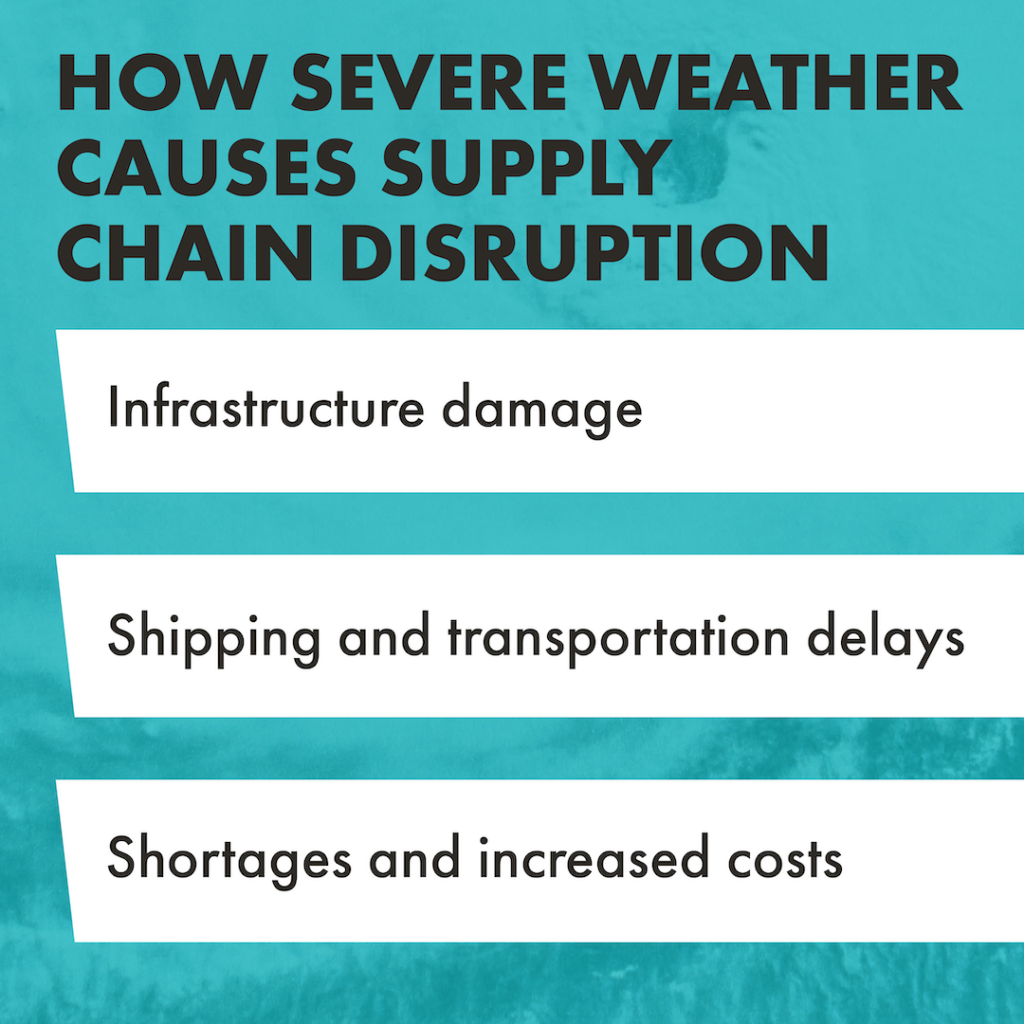
Infrastructure Damage
Roads, bridges, or ports can become damaged and make routes unavailable.
Shipping and Transportation Delays
The effects of severe weather, such as flooding or wind gusts, can slow or stop transit, causing delays and increased shipping times.
Shortages and Increased Costs
Damages and delays from severe weather can impact production, reducing inventory and capacity. Increased demand then increases the cost of materials, products, or shipping.
HOW SUPPLY CHAINS CAN STAY PROACTIVE
While you can’t control the weather, you can control whether your supply chain is prepared. Now is the time to be proactive and plan so your supply chain survives and thrives when severe weather strikes.
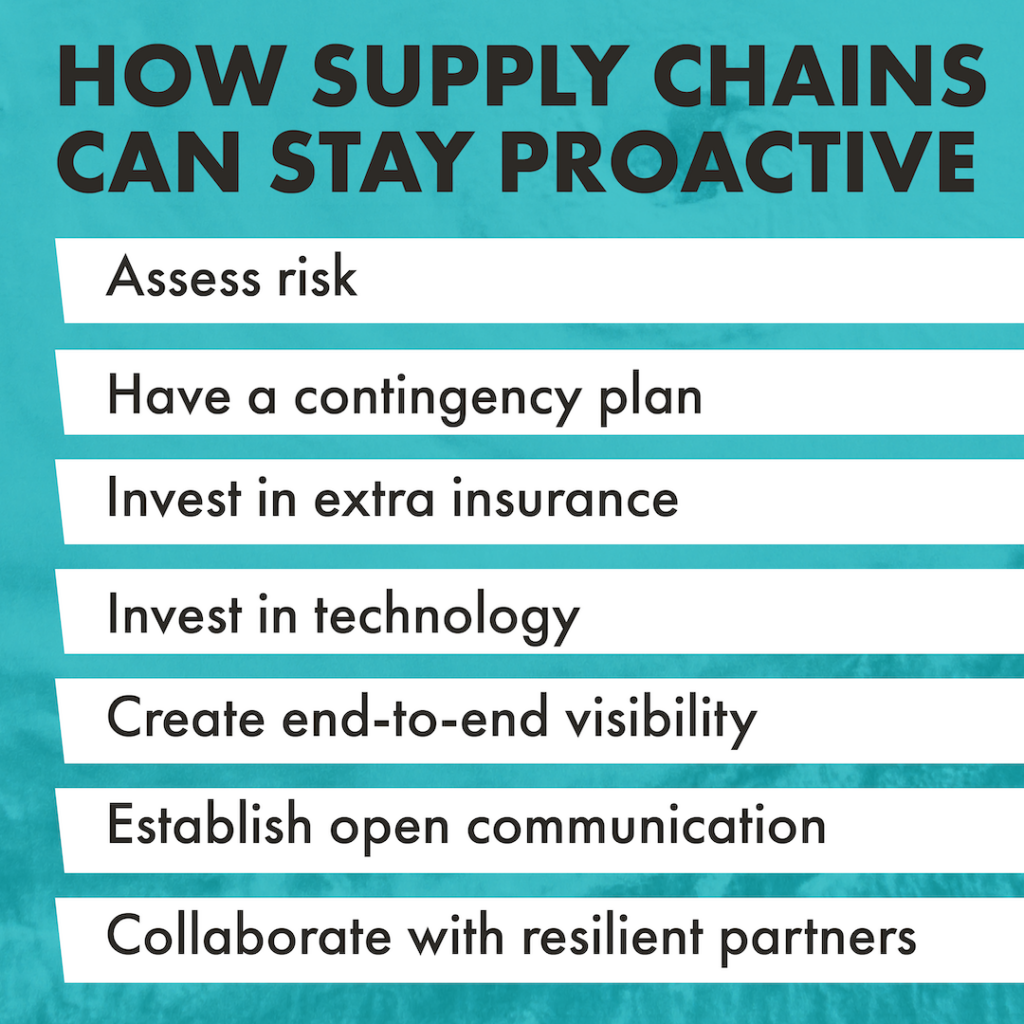
Assess Your Risk
Map out your entire supply chain to find gaps and vulnerabilities. Identify which companies and suppliers are involved and what severe weather events might impact them. If capable, look at previous data on supply chain disruption to learn from it. Are there certain sites that experience frequent disruption? How could you have been better prepared?
Have a Contingency Plan
Now that your supply chain is mapped and risks identified, it’s time to build plans for when disruption hits. Confirm that your supply chain partners have their own plan in place. Determine backup suppliers and partners for when current ones are affected. Find and select alternative transportation methods and routes. Once established, regularly assess this plan to ensure it will operate effectively.
Invest in Extra Insurance
This may seem like simple advice but invest in insurance to protect your business from losses. For example, flood or hurricane insurance will help you restore any damaged assets from a severe storm. Business interruption coverage can offer added protection, covering any lost sales during a disruption from severe weather.
Invest in Technology
There is a lot of technology available to help you be prepared for severe weather. Technology with Artificial Intelligence (AI) and predictive analytics can be useful to help you forecast and respond quickly when issues unfold. Leveraging AI and machine learning can help you reach a level of automation in which decisions can be made from data in a matter of seconds.
Create End-to-End Visibility
One of the most common weaknesses in supply chains is a lack of visibility. With the increase in severe weather and supply chain disruption, visibility is needed now more than ever. Having real-time access to tracking, carriers, suppliers, and inventory can help you identify any issues before disruption takes place.
A transportation management system (TMS) can provide the visibility you need. It provides critical data about your shipments and orders in real-time, giving you an advantage should a problem arise. This can help you make quick decisions to reroute shipments, avoid affected areas, and keep your customers informed.
See how a TMS could help you.Establish Open Communication
Establishing open communication among your supply chain partners now will benefit you when severe weather happens. Be transparent. Share details about when you receive orders, where they go, and when they are due.
Let partners know your backup plans and ensure they are prepared for any severe weather events. When there is a chance of supply chain disruption, send communications right away. The earlier you can make partners aware of the possibility, the more time they have to adjust their plans.
Collaborate with Resilient Partners
Are your supply chain partners prepared for potential disruption? Identify those who are ready to weather the storms and those who are vulnerable. Supply chain disruption isn’t going away, so you’ll want to raise your concerns and highlight your need for resiliency. If the risk is too great for your supply chain, you may consider looking into alternative partners to replace them.
WEATHER ANY STORM WITH TRINITY LOGISTICS
Working with a reliable logistics provider like Trinity Logistics is a great way to build supply chain resiliency and overcome severe weather threats.
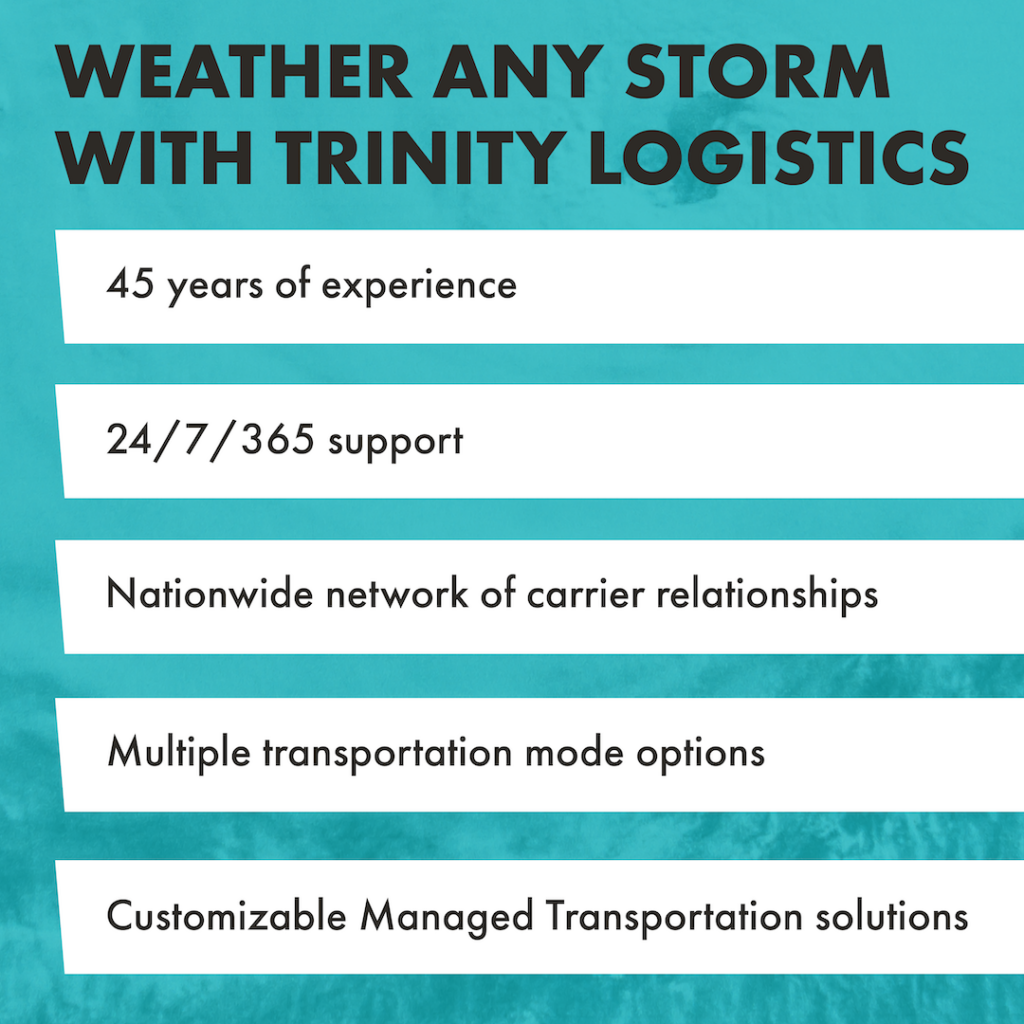
Trinity Logistics has been supporting thousands of supply chains through all sorts of supply chain disruption for over 45 years. Severe weather events don’t scare us away, as we thrive on quickly solving issues like those that storms can bring. We also have a dedicated After-Hours Team to support your business at any time. Even if severe weather halts your shipping overnight, on a holiday, or weekend, we’re here to help.
Our nationwide network of trusted carrier relationships will ensure your shipments arrive safely at their delivery locations. You can also count on our multiple transportation options to allow you to keep your goods moving through rain, hail, or snow. Lastly, our customizable Managed Transportation solutions can give you the real-time visibility you need to stay updated and make any changes in a matter of minutes.
Don’t let supply chain disruption fog up your company’s goals. Try Trinity Logistics and see how our People-Centric service can light the way to success.
GET A FREE QUOTE ON YOUR NEXT SHIPMENT SUBSCRIBE & STAY IN THE KNOW LEARN MORE ABOUT TRINITY'S SOLUTIONS

